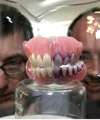Tooth protection from the sea

(�鶹��Ժ) -- A team of dentists and scientists from Newcastle University are developing a new product from a marine microbe to protect dentures, teeth and gums from bacteria in the mouth.
They are using an enzyme isolated from a marine bacterium Bacillus licheniformis found on the surface of seaweed which they were originally researching for the purpose of cleaning the hulls of ships.
But presenting at the Society for Applied Microbiology Summer conference today, they’ll explain how they are beginning to realise its potential in a host of medical environments – including teeth cleaning.
While toothpastes are fairly effective there are still hard to reach areas leaving the bacteria in plaque able to erode the enamel of teeth leading to fillings. Dr Nicholas Jakubovics of Newcastle University’s School of Dental Sciences believes better products can be made using the enzyme which will offer longer and more effective protection.
“Plaque on your teeth is made up of bacteria which join together to colonise an area in a bid to push out any potential competitors,” explained Dr Jakubovics. “Traditional toothpastes work by scrubbing off the plaque containing the bacteria – but that’s not always effective - which is why people who religiously clean their teeth can still develop cavities.
“Work in a test tube has shown that this enzyme can cut through the plaque or layer of bacteria and we want to harness this power into a paste, mouthwash or denture cleaning solution.”
When under threat, bacteria shield themselves in a slimy protective barrier. This slimy layer, known as a biofilm, is made up of bacteria held together by a web of extracellular DNA which adheres the bacteria to each other and to a solid surface – in this case in the plaque around the teeth and gums. The biofilm protects the bacteria from attack by brushing, chemicals or even antibiotics.
However, when studying the marine bacterium Bacillus licheniformis, Newcastle University scientists led by Professor Grant Burgess found that when the bacteria want to move on, they release an enzyme which breaks down the external DNA, breaking up the biofilm and releasing the bacteria from the web.
Professor Burgess said: “It’s an amazing phenomenon. The enzyme breaks up and removes the bacteria present in plaque and importantly, it can prevent the build up of plaque too.
“When I initially began researching how to break down these layers of bacteria, I was interested in how we could keep the hulls of ships clear but we soon realised that the mechanism we had discovered had much wider uses. If we can contain it within a toothpaste we would be creating a product which could prevent tooth decay.
“This is just one of the uses we are developing for the enzyme as it has huge potential such as in helping keep clean medical implants such as artificial hips and speech valves which also suffer from biofilm infection.”
The team’s next step is to further test and develop the product and they are looking to set up collaboration with industry.
More information:
Provided by Newcastle University
















